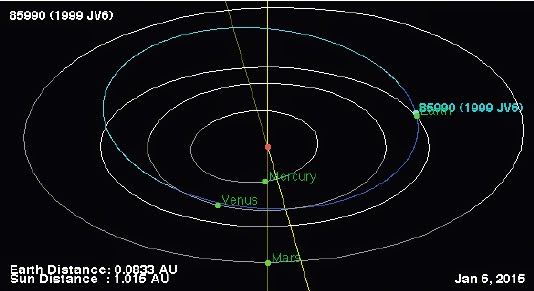Asteroid (410088) 2007 EJ passed by the Earth at a distance of about 26 500 000
km (68.9 times the average distance between the Earth and the
Moon, or 17.7% of the average distance between the Sun and the Earth),
slightly after 7.50 am GMT on Moday 12 January 2015. There was no
danger of the asteroid hitting us, though were it to do so it would have
presented a serious threat. (410088) 2007 EJ has an estimated
equivalent diameter of 1.1 km (i.e. it is estimated that a spherical
object with the same volume would be 1.1 km in diameter), and an
object of this size would be predicted to be capable of passing through
the Earth's atmosphere relatively intact, impacting the ground with an
energy equivalent to about 50 000 megatons of TNT (roughly 3 000 000
times the energy of the Hiroshima bomb). Such an event
would result in a crater about 15 km across, cause devastation
on a global scale and would have the potential to affect the climate
globally for centuries after the impact event.
The calculated orbit of (410088) 2007 EJ. JPL Small Body Database Browser.
(410088) 2007 EJ was discovered on 9 March 2007 by the University of Arizona's Mt. Lemmon Survey at the Steward Observatory
on Mount Lemmon in the Catalina Mountains north of Tucson. The
designation 2007 EJ implies that it was the 9th asteroid
(asteroid J) discovered in the first half of March 2007 (period
2007). The longer number, 410088, implies that it was the 410 088th asteroid ever discovered. This longer designation is not given to asteroids straight away, to avoid duplicate or false sightings.
(410088) 2007 EJ has a 1443 day year orbital period and an eccentric
orbit tilted at an angle of 7.29° to the plane of the Solar System, which
takes it from 0.93 AU from the Sun (i.e. 93% of the average distance at
which the Earth orbits the Sun) to 4.07 AU from the Sun (i.e. 407% of
the average distance at which the Earth orbits the Sun, considerably
more than twice the distance at which the planet Mars orbits the Sun). It is
therefore classed as an Apollo Group Asteroid (an asteroid that is on
average further from the Sun than the Earth, but which does get closer). This also means that close encounters between (410088) 2007 EJ and the Earth are fairly common, with the last having occured in February 2011 and the next predicted for November 2018.
See also...
 Fireball over Bucharest Witnesses reported seening a large fireball over Bucharest, Romania, at
about 3.00 am local time on Thursday 7 January 2015. The event is
reported to have lasted several seconds, and to have lit up the sky
'like...
Fireball over Bucharest Witnesses reported seening a large fireball over Bucharest, Romania, at
about 3.00 am local time on Thursday 7 January 2015. The event is
reported to have lasted several seconds, and to have lit up the sky
'like... Asteroid 1999 JV6 passes the Earth. Asteroid 1999 JV6 passed by the Earth at a distance of about 12 460 000
km (32.42 times the average distance between the Earth and the
Moon, or 8.3% of the average distance between the Sun and the Earth)...
Asteroid 1999 JV6 passes the Earth. Asteroid 1999 JV6 passed by the Earth at a distance of about 12 460 000
km (32.42 times the average distance between the Earth and the
Moon, or 8.3% of the average distance between the Sun and the Earth)... Asteroid 2005 YQ96 passes the Earth. Asteroid 2005 YQ96 passed by the Earth at a distance of about 3 967 000
km (10.32 times the average distance between the Earth and the
Moon, or 2.7% of the average distance between the Sun and the Earth)...
Asteroid 2005 YQ96 passes the Earth. Asteroid 2005 YQ96 passed by the Earth at a distance of about 3 967 000
km (10.32 times the average distance between the Earth and the
Moon, or 2.7% of the average distance between the Sun and the Earth)... 
